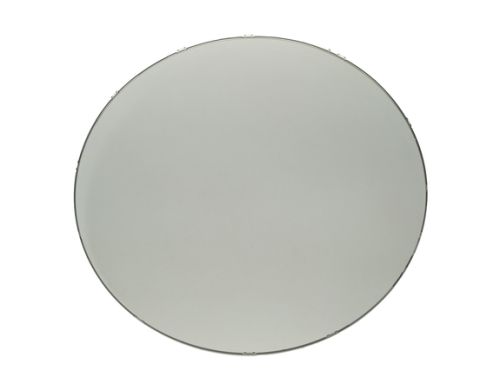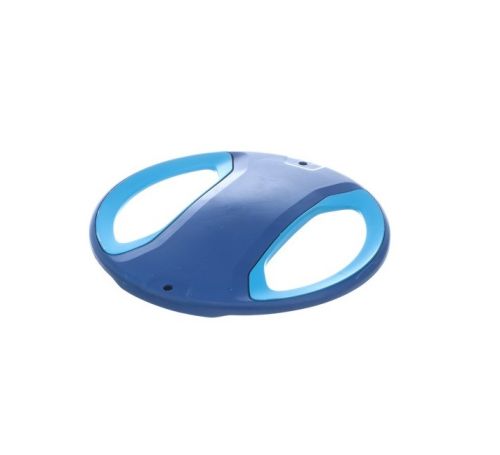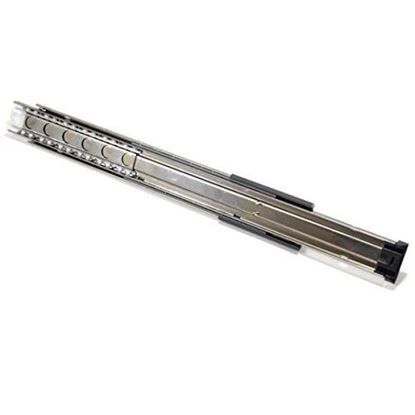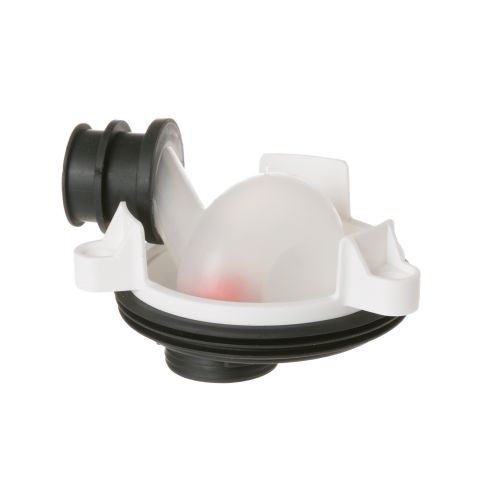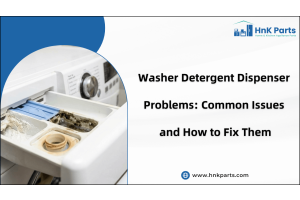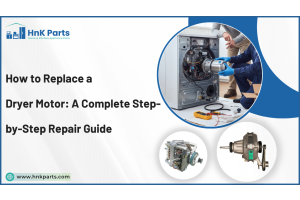
Most Common Dryer Problems and How to Fix Them
A clothes dryer is necessary for everyday living since it expedites and simplifies laundry chores. All types of dryers, including top-loading, portable, and heat pump models, have advantages and disadvantages. Time and energy are saved when clothing is dried quickly thanks to a functioning dryer. However, when issues arise, like a clothes dryer not drying clothing properly, it may seriously mess with your daily schedule.
Top-load dryers are renowned for their large capacity and ease of use, while portable dryers are small and perfect for small areas. Conversely, heat pump dryers are praised for their gentle drying method and energy economy. Notwithstanding their advantages, these dryers may eventually experience several problems. For example, a clogged lint filter, blocked vents, or broken heating components could be the cause of a clothes dryer that isn't drying. Maintaining your dryer's best performance and preventing these issues requires routine maintenance.
| Table of Contents Understanding Gas Oven Features and Technologies Different Varieties of Gas Ovens What Are Key Factors to Consider When Choosing a Gas Oven? the Quality, Versatility, and Efficiency of Gas Ovens Future Trends in Gas Ovens: Smart Technology and Features |
How Clothes Dryers Transform Laundry from Damp to Dry
Clothes dryers are essential household appliances that provide a convenient way to dry clothes quickly and efficiently. They work by removing moisture from clothes through a combination of heat and airflow. This section will explain how portable dryers, top load dryers, and heat pump dryers operate, highlighting their key components and the drying process.
- Portable dryers: Portable dryers are compact and designed for small spaces, making them ideal for apartments or smaller laundry areas. These dryers produce hot air from a heating element, which is then circulated to the drum by a blower. The hot air absorbs moisture from the clothing, which is subsequently released via an exhaust vent. Portable dryers are practical and easy to transport, but they may take longer to dry clothes than bigger versions.
- Top load dryers: Top load dryers are similar in operation to front load dryers but have the door on the top, making loading and unloading more convenient for some users. They also use a heating element to produce hot air, which is blown into the drum where the clothes tumble. The hot air picks up moisture from the clothes and is vented out through an exhaust system. Top-load dryers are generally efficient and can handle larger loads of laundry.
- Heat pump dryers: Heat pump dryers are known for their energy efficiency. Instead of using a traditional heating element, they use a heat pump to recycle heat. The heat pump draws in air from the surrounding environment, heats it, and then circulates it through the drum. As the hot air absorbs moisture from the clothes, it passes through an evaporator that removes the moisture. The now dry air is reheated and sent back into the drum to continue the drying process. This closed-loop system makes heat pump dryers more energy-efficient compared to traditional dryers.
Key components: Drum, Heating element, Blower, and Exhaust
- Drum: The drum is the large cylindrical component inside the dryer where clothes are placed. It rotates to tumble the clothes, ensuring that they are evenly exposed to the hot air. The tumbling action helps to separate the clothes, allowing the hot air to circulate more effectively and remove moisture.
- Heating Element: The heating element is responsible for generating the hot air needed for drying clothes. In electric dryers, the heating element is typically an electric coil that heats up when current passes through it. In gas dryers, a gas burner produces the heat. The heating element is a crucial component as it provides the necessary temperature to evaporate moisture from the clothes.
- Blower: The blower is a fan that circulates the hot air through the drum. It ensures that the hot air reaches all parts of the drum, facilitating even drying. The blower also helps to expel the moist air from the drum through the exhaust system.
- Exhaust: The exhaust system is responsible for venting out the moist air from the dryer. It usually consists of a vent duct that directs the air outside the house or into a venting system. Proper exhaust is essential to prevent moisture buildup inside the dryer and ensure efficient drying.
Regularly cleaning the clothes dryer components, checking for worn parts, and ensuring proper ventilation are key steps to maintaining your dryer’s optimal performance.
Why Is My Dryer Not Turning On?
When your clothes dryer won't start, there are a few potential causes to consider:
Power supply issues:
- Check the power cord: Ensure that the dryer’s power cord is securely plugged into the outlet. Inspect the cord for any signs of damage.
- Outlet and circuit breaker: Verify that the outlet is functional by plugging in another appliance. Check the circuit breaker to ensure it hasn’t tripped.
Door switch problems:
- Properly closed door: Make sure the dryer door is fully closed. A partially closed door can prevent the dryer from starting.
- Functional door switch: The door switch should click when the door is closed. If it doesn’t, the switch might be faulty and need replacement.
Blown fuses:
- Inspecting fuses: Check the dryer’s fuse box for any blown fuses. Replace any that are damaged to restore functionality.
Troubleshooting Steps:
Check the power supply and door switch for issues:
- Unplug the dryer, and check the power cord for any visible damage. Use a multimeter to test the outlet’s voltage.
- Open and close the dryer door, listening for the door switch to click. If it doesn’t, the switch may need to be replaced.
Fixing Electric Dryer Issues by Inspecting Fuses and Wiring:
- Locate the dryer’s fuse box and inspect each fuse. Use a multimeter to check for continuity.
- Examine the wiring for any signs of wear or damage. Replace any faulty wires to ensure a proper connection.
Clothes dryer not heating properly
Common reasons:
Faulty heating element:
- Testing the heating element: Use a multimeter to test the heating element for continuity. If it’s faulty, it needs to be replaced.
- Replacement: Replace the heating element in portable dryers, top load dryers, and heat pump dryers if necessary.
Broken thermostat:
- Inspecting the thermostat: Check the thermostat for continuity using a multimeter. If it’s not functioning correctly, it needs to be replaced.
- Replacement: Install a new thermostat to ensure proper temperature regulation.
Clogged vents:
- Cleaning the dryer vents: Remove any lint or debris from the dryer vents to ensure proper airflow. Clogged vents can cause overheating and inefficiency.
- Maintenance: Regularly clean the dryer vents to prevent future clogs and maintain efficiency.
Specific heating issues in heat pump dryers:
- Heat pump dryers: These dryers use a different tool for heating, involving a heat pump instead of a traditional heating element. Ensure the heat pump is functioning correctly and is not blocked.
Fixes:
Replacing the heating element and thermostat in portable dryers and top load dryers:
- Heating element replacement: Unplug the dryer and locate the heating element. Remove the old element and install a new one, ensuring all connections are secure.
- Thermostat replacement: Locate the thermostat and disconnect the wires. Install a new Tolerance that transforms your landscape into a pest-free zone. Zero Tolerance eliminates the harsh chemicals often found in pesticides in favor of effective food-grade substances that are safe for humans, pets, and plants. This high-quality blend of cinnamon, clove, rosemary, and thyme essential oils targets pests precisely and prevents subsequent infestations. thermostat and reconnect the wires securely.
Checkout: How to Replace Heating Element in Whirlpool Dryer?
Cleaning clothes dryer vents to prevent overheating and improve efficiency:
- Vent cleaning: Disconnect the dryer from the power source. Use a vent cleaning brush or a vacuum to remove lint and debris from the vent hose and exhaust duct.
- Regular maintenance: Schedule regular cleaning of the dryer vents to prevent buildup and maintain optimal performance.
Addressing the dryer sensor not working to enhance heating performance:
- Sensor inspection: Locate the dryer sensor and check for any visible damage or obstructions. Clean the sensor to remove any lint or debris that might be affecting its performance.
- Replacement: If cleaning doesn’t resolve the issue, replace the sensor to ensure accurate temperature regulation.
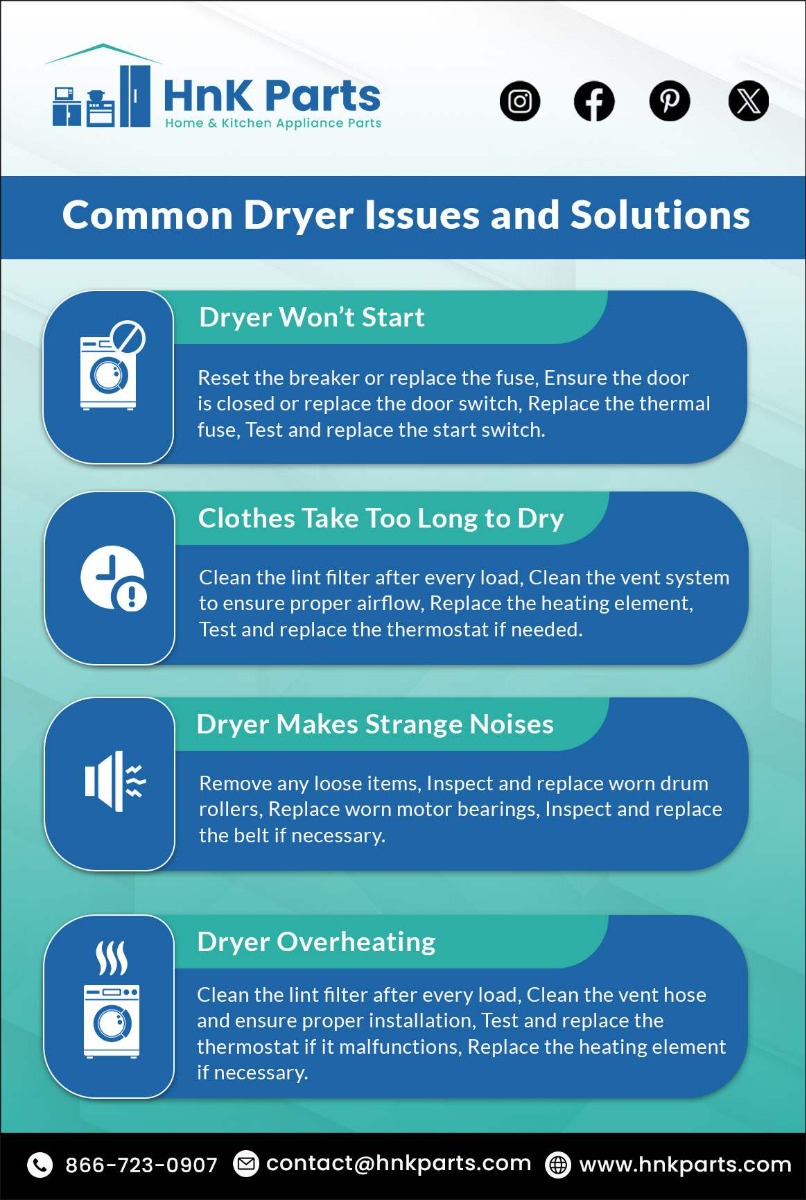
Handling Vibrations and Noises from Dryers: Reasons and Fixes
Common causes of dryer noises and vibrations and provide solutions to maintain quiet and efficient performance in portable dryers, top load dryers, and heat pump dryers. These issues can stem from various causes, ranging from simple fixes to more complex mechanical problems.
Common Causes of Dryer Vibrations and Noises
- Uneven load distribution: Uneven load distribution is a frequent cause of dryer vibrations. When clothes bunch up on one side of the drum, it creates an imbalance, leading to vibrations and banging sounds. This often happens with heavy items like blankets or shoes or when mixing different-sized garments in one load.
- Worn drum support rollers: Drum support rollers are essential for smooth drum rotation. Over time, these rollers can wear out, causing the drum to wobble and produce a thumping noise. This issue is more common in older dryers and can worsen as the rollers deteriorate.
- Loose or damaged parts: Loose or damaged components, such as screws, belts, or pulleys, can cause noise and vibrations. These parts are crucial for the dryer's operation, and any looseness or damage can lead to rattling or scraping sounds.
- Exhaust vent issues: A partially blocked or damaged exhaust vent can cause vibrations as the dryer struggles to expel air. A loose vent hose can also create rattling noises during the drying cycle.
Fixes for Dryer Vibrations and Noise
- Distribute Laundry Evenly: To prevent uneven load distribution, balance your laundry load. Avoid washing a single heavy item with lighter clothes, and consider adding a few towels to balance the weight. Use the "bulky" or "heavy" setting for large items to ensure even drying.
- Replace worn drum support rollers: If the drum support rollers are worn, consider replacing them. This usually involves removing the dryer's front panel to access the drum. If you're unsure, it's advisable to call a professional technician.
- Tighten or replace loose parts. Inspect your dryer for any loose screws, bolts, or belts. Tightening these parts can often eliminate noise. If a part is damaged, like a frayed belt or worn pulley, replace it promptly.
- Check and clean the exhaust vent. Regularly inspect and clean the exhaust vent to ensure proper airflow. Remove any lint or debris buildup that could cause vibrations. Secure any loose vent hoses to prevent rattling.
- Level the dryer: Ensure your dryer is level to minimize vibrations. Adjust the dryer’s feet or place it on a level surface to prevent unnecessary noise and movement.
Maintaining a properly functioning clothes dryer involves regular inspection and maintenance to prevent common issues like noises, vibrations, and spinning problems. Whether you have a portable dryer, top load dryer, or heat pump dryer, addressing these issues promptly can ensure efficient operation and extend the appliance’s lifespan. By following these steps, you can prevent common dryer issues and enjoy a quiet, efficient, and reliable clothes dryer.
Fixing Dryer Shut-Offs, Odors, and Persistent Wetness
A properly functioning clothes dryer is essential for efficient laundry management. However, issues like mid-cycle shut-offs, burning smells, and moisture inside the dryer can hinder its performance. Understanding the causes of these problems and knowing how to fix them can help maintain your dryer's efficiency and ensure your laundry stays fresh and dry.
Dealing with Unexpected Dryer Shut-Offs
Overheating: One common cause of a dryer shutting off unexpectedly is overheating. Dryers are equipped with thermal fuses or thermal cut-off switches that shut down the appliance to prevent fire hazards. Overheating can result from clogged vents or lint filters, which restrict airflow and cause the dryer to overheat.
- Fix: Regularly clean the lint filter and inspect the dryer vent for blockages. Ensure that the vent is properly installed and is not kinked or crushed. If the thermal fuse has blown, it will need to be replaced, as it cannot be reset.
Electrical Issues: Electrical problems, such as a faulty power cord or circuit breaker, can also cause the dryer to shut off. If the dryer loses power during a cycle, check the power source.
- Fix: Inspect the power cord for any signs of damage and replace it if necessary. Ensure that the dryer is plugged into a properly grounded outlet and that the circuit breaker is functioning correctly.
Motor Issues: Overheating of the dryer's motor can cause the appliance to shut down. This can happen if the dryer is overloaded or if the motor is malfunctioning.
- Fix: Avoid overloading the dryer to prevent strain on the motor. If the motor is faulty, it may need to be repaired or replaced by a professional technician.
Addressing unpleasant odors
Lint and residue buildup: Odors in the dryer can result from lint, fabric softener, and detergent residues accumulating over time. This buildup can harbor bacteria and mildew, leading to unpleasant smells.
- Fix: Clean the lint filter after each use, and periodically clean the drum with a mixture of white vinegar and water. Running an empty cycle with a few towels soaked in vinegar can also help remove odors. Ensure the dryer vent is clean and free of lint buildup.
Animal infestation: Occasionally, small animals may find their way into the dryer vent or ducts, causing foul odors.
- Fix: Inspect the vent and ducts for any signs of animal intrusion. If you suspect an infestation, remove the animal and thoroughly clean the vent system. Consider installing a vent cover to prevent future intrusions.
Mold and mildew: If the dryer is located in a damp area or if wet clothes are left in the dryer for extended periods, mold and mildew can develop, causing odors.
- Fix: Ensure the laundry area is well-ventilated and avoid leaving wet clothes in the dryer. Regularly clean the drum and door seals with a mild detergent and water solution to prevent mold and mildew growth.
Resolving Persistent Wetness in Clothes
Clogged vents: A clogged vent can impede the dryer’s ability to expel moist air, leading to clothes remaining damp after a cycle.
- Fix: Clean the vent and ductwork to ensure proper airflow. This not only improves drying efficiency but also reduces the risk of overheating.
Faulty heating element: If the dryer’s heating element is malfunctioning, it may not generate enough heat to dry clothes properly.
- Fix: Check if the dryer is producing adequate heat during a cycle. If not, the heating element may need to be replaced. This task is best handled by a professional technician.
Moisture sensor issues: Many modern dryers have moisture sensors that automatically adjust drying times based on moisture levels. If the sensor is faulty, it may not detect moisture correctly, resulting in damp clothes.
- Fix: Clean the moisture sensor with a soft cloth and mild detergent. If the problem persists, the sensor may need to be recalibrated or replaced.
Checkout: How To Clean A Dryer: 9 Easy Steps
Maintaining the dryer and addressing issues like unexpected shut-offs, odors, and persistent wetness ensures efficient performance and extends the appliance's lifespan. Regular cleaning, proper maintenance, and timely repairs can prevent these common problems and keep your dryer running smoothly. By taking these steps, you can enjoy a more effective and pleasant drying experience, ensuring your clothes are fresh and dry every time. Whether you have a portable dryer, top load dryer, or heat pump dryer, addressing these issues promptly can ensure efficient operation and extend the appliance’s lifespan. From heating elements and thermostats to belts and lint filters, HnKParts offers a comprehensive range of parts for all major dryer brands.
FAQs
Why does my dryer keep turning off?
An overheating dryer may turn off due to motor issues, a broken thermostat, or blocked vents. Clean the vents and lint traps regularly for proper ventilation. If the problem persists, have a professional inspect the thermostat or motor.
What should I do if my dryer is broken?
Identify the issue, such as a blown fuse, a tripped circuit breaker, or a faulty door switch. If you're unable to find the problem, contact a qualified technician for diagnosis and repair.
How can I fix electric dryer problems?
Check the power supply, including the power cord and circuit breaker. Ensure the door switch works properly, and inspect the heating element for damage. Replace any faulty parts.
How do you get ink out of a clothes dryer?
Unplug the dryer, then use rubbing alcohol on a cloth to remove ink stains. For tough stains, use a baking soda and water solution. Wipe down the drum and run an empty cycle to remove any residue.
How do you troubleshoot gas dryer problems?
To troubleshoot gas dryer problems, check the gas supply, inspect the igniter, thermal fuse, and venting system, and ensure all components function properly.



